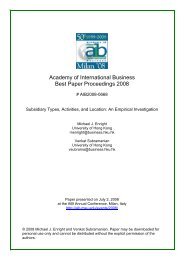AIB 2012 Conference Proceedings - Academy of International ...
AIB 2012 Conference Proceedings - Academy of International ...
AIB 2012 Conference Proceedings - Academy of International ...
Create successful ePaper yourself
Turn your PDF publications into a flip-book with our unique Google optimized e-Paper software.
MONDAY<br />
Structuring and Pricing <strong>of</strong> <strong>International</strong> Syndicated Corporate Loans<br />
Ha-Chin Yi, Texas State University<br />
Byung-uk Chong, Ewha Womans University, Seoul, Korea<br />
This paper examines how syndicate structure affects the risk premium <strong>of</strong> internationally syndicated loans in<br />
both developed and developing countries. Syndicate structure is an organizational response to information<br />
asymmetry in syndicate composition. The lead bank assumes a risky position as a lender by retaining a fraction<br />
<strong>of</strong> the loan, and also acts as the intermediary between the borrower and the syndicate participants by allocating<br />
loan shares to participants. Between the two competing hypotheses <strong>of</strong> syndicate structure – concentration<br />
hypothesis versus diversification hypothesis, most <strong>of</strong> the estimations support the diversification hypothesis. This<br />
paper finds that a portion <strong>of</strong> loan retained by lead arranger is negatively related to loan risk premium. As the<br />
riskiness <strong>of</strong> borrowing firm increases, lead arrangers and participating banks share the loan amounts since<br />
participating banks may possess information through which they can assess the riskiness <strong>of</strong> the borrowing firm<br />
as accurate as the lead arrangers do. Therefore, a lead arranger intends to provide appropriate risk premium to<br />
participating banks in order to seek for their syndicate participation; otherwise, the lead bank should be willing<br />
to retain more loan shares to credibly signal to participants to certify loan quality. (For more information, please<br />
contact: Ha-Chin Yi, Texas State University, USA: hy11@txstate.edu)<br />
Executives as Agents: Expatriate Managers in Subsidiaries <strong>of</strong> Multinational Banks<br />
Hein Bogaard, George Washington University<br />
Marketa Sonkova, Boston University<br />
The theoretical and empirical literature on (international) banking identified a trade-<strong>of</strong>f between the need for<br />
local "s<strong>of</strong>t" information on clients and the creation <strong>of</strong> information asymmetries between the principal (bank<br />
headquarters) and the agent (a foreign subsidiary). This paper investigates how multinational banks manage<br />
the trade-<strong>of</strong>f through executive staffing in their emerging market subsidiaries. In particular, we create a unique<br />
dataset to study how bank strategy and host country institutions affect the choice between home country and<br />
host country executives. We anticipate that (i) strategies that require local knowledge or s<strong>of</strong>t information create<br />
a preference for host country executives and that (ii) weak institutions that reduce transparency and amplify<br />
information asymmetries between principal and agent increase the preference for home country executives.<br />
(For more information, please contact: Hein Bogaard, George Washington University, USA: hbogaard@gwu.edu)<br />
Are Bank Dividends a Signal to Informed Depositors<br />
Cristiano Forti, Fundação Getúlio Vargas<br />
Rafael Felipe Schiozer, Fundação Getúlio Vargas<br />
This study investigates whether the composition <strong>of</strong> bank debt affects payout policy. We exploit the features <strong>of</strong><br />
the Brazilian banking system, such as the existence <strong>of</strong> several closely held banks, owned and managed by a<br />
small group <strong>of</strong> shareholders, for which shareholder-targeted signaling is implausible, and find that banks that<br />
rely more on informed (institutional) depositors for funding pay larger dividends, controlling for other features.<br />
During the financial crisis, when the Brazilian banking system suffered the contagion <strong>of</strong> the liquidity freeze in<br />
international banking systems, this effect was even more pronounced, i.e. banks that relied on institutional<br />
investors paid even higher dividends. This relationship reinforces the role <strong>of</strong> dividends as a costly and credible<br />
signal about the quality <strong>of</strong> bank assets. (For more information, please contact: Rafael Felipe Schiozer, Fundação<br />
Getúlio Vargas, Brazil: rafael.schiozer@fgv.br)<br />
<strong>AIB</strong> <strong>2012</strong> <strong>Conference</strong> <strong>Proceedings</strong><br />
Page 156

















